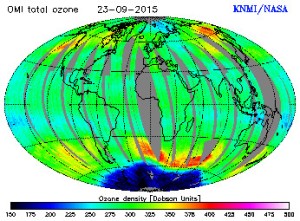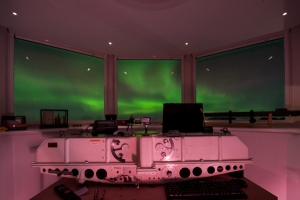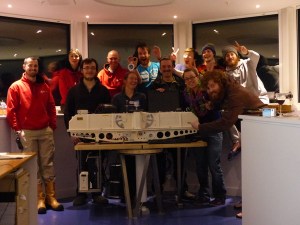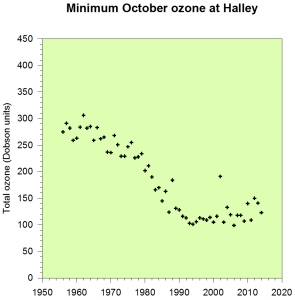
23/09/15 Near real time ozone columns
Source: http://www.temis.nl
Ozone has been measured at Halley since 1956 using the Dobson spectrophotometer. The instrument compares the intensity of two light wavelengths: one that is strongly absorbed by ozone and one that is not affected by ozone. From the ratio of both their intensities, the amount of ozone in the stratosphere (between 10 and 50km from the ground) is derived.
While ozone is toxic at Earth’s surface, in the stratosphere it is protecting us against harmful ultra violet causing sunburns and skin cancers. Since the 80’s the amount of ozone has dropped every spring (September/October) with the return of the sun. This ozone depletion has not been only observed over Halley, but all over Antarctica. Ozone is being destroyed by chlorine released by man-made chlorofluorocarbons (CFC).
The “ozone hole” discovery made by the British Antarctica Survey in 1985 resulted in the Montreal Protocol which aimed to reduce and control the production of CFCs. Since then the amount of ozone-destroying substances has been declining and the ozone depletion is stabilizing which might indicate a slow recovery of the ozone layer over Antarctica.
Nowadays, daily measurements of the ozone are still performed using the Dobson spectrophotometer.
Les premières mesures d’ozone à Halley ont été réalisées en 1956 à partir d’un spectrophotomètre Dobson. Cet instrument compare les intensités de deux longueurs d’ondes : l’une absorbant fortement l’ozone, l’autre étant très peu affectée par l’ozone. La quantité totale d’ozone dans la stratosphère (de 10 à 50km d’altitude) est dérivée du rapport de ces deux intensités.
Si l’ozone est nocif à la surface terrestre, dans la stratosphère il nous protège contre les rayonnements ultra-violet dangereux à l’origine des coups de soleil et des cancers de la peau. Depuis les années 80, la quantité d’ozone stratosphérique chute chaque printemps (Septembre/Octobre) avec le retour du soleil. Cette destruction de la couche d’ozone n’est pas seulement observée à Halley mais partout en Antarctique. L’ozone est détruit par des composés chlorés dérivés des chlorofluorocarbures produits par l’homme.
La découverte du trou de la couche d’ozone par la British Antarctique Survey en 1985 a conduit au protocole de Montréal qui limite et contrôle la production des CFCs. Depuis lors la quantité de composés à l’origine de la destruction de l’ozone est en déclin et la destruction de la couche d’ozone se stabilise ce qui pourrait indiquer une lente guérison de la couche d’ozone.
Aujourd’hui encore les mesures de l’épaisseur de la couche d’ozone sont réalisées quotidiennement à Halley à partir d’un spectrophotomètre Dobson.




